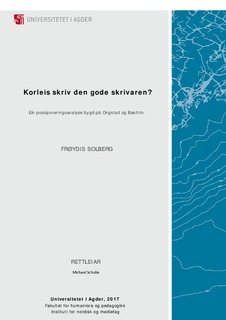| dc.description.abstract | This Master Thesis is a research of texts written for the final exam in Norwegian as first
language at upper secondary school in spring 2016. The survey comprises texts written by
students both from adult education centres and upper secondary schools. In this project, 103
exam writers participate and 84 out of these volunteered to answer a survey about writing. In
this paper I seek answers to the following question: «How does the good writer write? An
analysis of positioning based on Ongstad and Bakhtin. »
The survey of the exam texts has its origin in Sigmund Ongstad’s Theory of Positioning,
which he bases on genre theory and on Mikahil Bakhtin’s triadic view on utterances. He
focuses on the relation between the three aspects of form, content and use. Thus, the utterance
is viewed from three different angles in the analyses. The first focus is on what the utterance
reveals regarding the speaker’s relation to his own utterance. The second focus is on what the
utterance expresses in terms of logical meaning. Lastly, the focus is on what the intention and
outcome may be with regards to the receiver of the utterance. Beside genre theory, other
theories regarding text and writing are dealt with, as well as what can be learnt from research
when it comes to good writers and how this ought to influence teaching and writing
instructions.
From theory, I find two main aspects as to what good writers do. Firstly, research shows that
it is difficult to write for an unknown reader. However, good writers manage to write readeroriented.
Secondly, it is a fact that all writers face difficulties in the writing process. To
succeed, the writers need self-efficacy beliefs and skills in how to deal with such difficulties.
Such qualities influence how they approach to writing, how deeply they engage in the process
and the result they get. Good writers are expecting to succeed and they have the experiences
required to overcome obstacles.
89
The analyses of the texts show that the main obstacle for the writers is to make their text
reader-oriented by meeting the requirements given in the task. The survey reveals the same
problem. Several tell that it is difficult to know what the external examiner wants and I find it
disturbing that as many as 37% of the writers never think of the reader. Only 25% of the
writers focus on the reader throughout the whole writing process.
The survey reveals that up to as many as 63% of the writers got lower marks for the exam
papers than what they had been awarded for classwork. That led to a further examination of
reports from external examiners and other reports from the examination. This reading makes
me question the validity of the exam. The Norwegian Directorate of Education and Training
has started a reform process of renewing the school subjects, which in turn will lead to
changes in curriculum and eventually in the outline of the exam. In my opinion, a stronger
emphasis on making the writers prepared for academic writing is needed. Thus, there is a need
for clarification when it comes to what and how the good writer shall write. | nb_NO |

